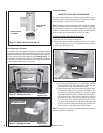
22
NOTE: DIAGRAMS & ILLUSTRATIONS ARE NOT TO SCALE
Figure 35 - Hopper Lid, Profi le 20 FS-2
Clinkering - Silica (or sand) in the fuel, along
with other impurities, can cause clinkering. A
clinker is a hard mass of silica formed in the
burning process. Clinkering is a function of the
fuel, (not the stove), but adversely affects the
performance of the stove by blocking off the
air passages in the grate. Even P.F.I. approved
pellet fuel may tend to clinker. A clinker can be
removed from the UltraGrate™ and placed in
the ash pan with the use of the grate scraper
/ ash pan tool furnished with your stove. See
Routine Maintenance (on Pages 22 to 28) for
more information on cleaning.
Ash - The frequency of removal of the ash
and maintenance performed on the stove is
directly proportional to the ash content of the
fuel and the operation duration of your pellet
stove. Low ash fuel may allow longer intervals
between cleaning, however, a stove burning
high ash fuel may need to be cleaned as often
as everyday.
PLEASE NOTE: Lennox Hearth Products has
no control over the manufacturing of pellet fuel
and will not be held responsible for poor stove
performance or any damage caused by poor
quality pellet fuels.
Fuel Feed Rates - Different brands of pellets
will feed at varying rates due to their size and
density (length and diameter). This may require
a slight adjustment in the damper control (see
Page 9) or the fuel feed trim to compensate
(see note at the top of Page 19).
Figure 36 - UltraGrate™
Fuel Specifi cations - Using the UltraGrate burn
system, this appliance has been designed to
burn wood residue pellets with up to 3% ash
content. Agricultural pellets (i.e. corn, alfalfa
etc.) are not permitted to be burned in these
appliances. Dirty fuel will adversely affect the
performance of the stove.
CAUTION: THE USE OF UNAPPROVED, DIRTY,
WET AND / OR HIGH SALT CONTENT FUEL
WILL VOID THE WARRANTY!
Wood pellets manufactured to the pellet fuels
institute (P.F.I.) certifi cation standard are avail-
able in two grades, Standard and Premium. The
primary difference between the two is the ash
content of the pellets.
The P.F.I. specifi cation for standard grade
and premium grade residential pellet fuel
is as follows:
• CHLORIDES (Salt): Less than 300 p.p.m.
• BULK DENSITY: 40 lb. / Cu. Feet minimum
• MOISTURE CONTENT: 8% maximum
• ASH CONTENT: < 3% maximum (standard
grade) < 1% maximum (premium grade)
• FINES: 0.5% maximum through a 1/8”
screen
• BTU CONTENT: Minimum 8200 BTU per
pound.
Pellet Feed / Pellet Size - The pellet feed
system is designed to handle a wide range of
pellet sizes up to a maximum of 5/16” diam-
eter. Different pellets may feed at considerably
different rates. You may notice a difference in
the burn if you change pellet fuel sizes. The
longer the pellet, the slower it will feed and
vice versa. If the stove will not stay burning at
the minimum fuel feed setting, those particular
pellets may not be feeding fast enough. If this
happens, reduce the amount of combustion air
by adjusting the damper. See Page 9 before
adjusting the damper.
The following areas need to be inspected and
cleaned during routine cleaning:
• Heat Exchange Tubes / Tube Scraper
• Baffl e Plates
• Window Wash
• Ash Clean-Out Ports
• UltraGrate (Burn Grate)
• Ash Slide Plate (free-standing models
only)
• Ash Pan
• Exhaust Passages / Vent Pipe and Creosote
Removal
• Gaskets
• Photoeye
• Paint Touch-up
• Cleaning Rear Stove Compartment
Heat Exchange Tubes (All Models)
Clean Heat Exchange Tubes Only When The
Appliance is Cool.
Tube Scraper
Using the hole in the handle of the Grate Scraper
Tool to “grab” onto the rod. Using the Grate
Scraper Tool, pull the rod up and out towards
the opening of the fi rebox. Continue pulling
until the Tube Scraper reaches the top of the
fi rebox. The rod is located on the outside,
above the door. Pull the tube scraper out, then
repeat 2–3 times to remove fl y ash from the
heat exchange tubes.
Long Burn Time - When operated correctly,
this appliance cannot be overfi red. Continuous
operation at a maximum burn can, however,
shorten the life of the electrical components
(blowers, motors, and electronic controls), and
is not recommended. Typical approved operation
would include running at the low to mid range
setting with occasional running on the maximum
setting during the coldest periods of the winter.
The blower speed control should be turned to
high when operating the stove on the high heat
setting. A lower heat setting is recommended
for overnight operation or when the room is
vacated for long periods of time.
Note: See Fuel Delivery Rate on Page 20 for
burn times.
Pellet Fuel Hopper - It is recommended to
open the hopper lid by grasping it on the side
as shown in Figure 35.
Open Hopper Lid by Grasping the Side
BE VERY CAREFUL NOT TO TOUCH
OTHER HOT AREAS ON STOVE!
FUEL
ROUTINE MAINTENANCE
Cleaning
IMPORTANT
Unplug and Ensure Stove is Cold
Before Performing Any Mainte-
nance Work.


















